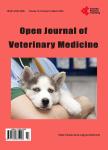Development and Body Composition of Quarter Horse Foals during Nursing
Development and Body Composition of Quarter Horse Foals during Nursing作者机构:Núcleo de Pesquisa Equina Departamento de Zootecnia Universidade Federal Rural de Pernambuco Recife Brazil
出 版 物:《Open Journal of Veterinary Medicine》 (兽医学(英文))
年 卷 期:2014年第4卷第11期
页 面:276-280页
学科分类:1002[医学-临床医学] 100214[医学-肿瘤学] 10[医学]
主 题:Body Mass Fat-Free Mass Fat Percentage Horse Ultrasound
摘 要:The monitoring and development of foals, based on biometric indices, and the determination of body composition could be important for genetic improvement and the elaboration of nutritional plans for horses. Considering that little information was available, the aim of the present study was to assess the growth and determine the body composition of suckling Quarter Horse foals. Animals (n = 46) of both sexes were monitored monthly from birth until the fifth month of age, using an ultrasound device and the following measurements: Wither Height (WH);Chest Perimeter (CP);Cannon Bone Circumference (CBC) Cannon Bone Girth (CG);Body Mass (BM);and Rump Fat Thickness (RFT). These tests determined the Fat-Free Mass (FFM), BM, Fat Percentage (FP) and Fat Thickness (FT). The data were analyzed using ANOVA and Tukey’s test, with differences considered statistically significant when P ≤ 0.05. The results demonstrated that the parameters analyzed changed significantly during the study period. The BM was ~41 at birth and ~177 kg at the point of weaning. Conversely, the FM was ~3.8 at birth and 18.1 kg at the point of weaning. The FFM was ~37 and ~160 kg at the time of birth and weaning, respectively. The FP varied from 9.3 at birth to 9.54 at weaning. The mean FT was ~1.39 and ~1.91 cm at birth and weaning, respectively. The WH measured ~91 at birth and 116 cm at weaning. In conclusion, suckling foals gain BM quickly from the time of birth to the time of weaning. The main cause of this gain is FFM. Therefore, due to the significant changes in the parameters studied herein, it is important to monitor these values in order to prevent nutritional imbalances.



